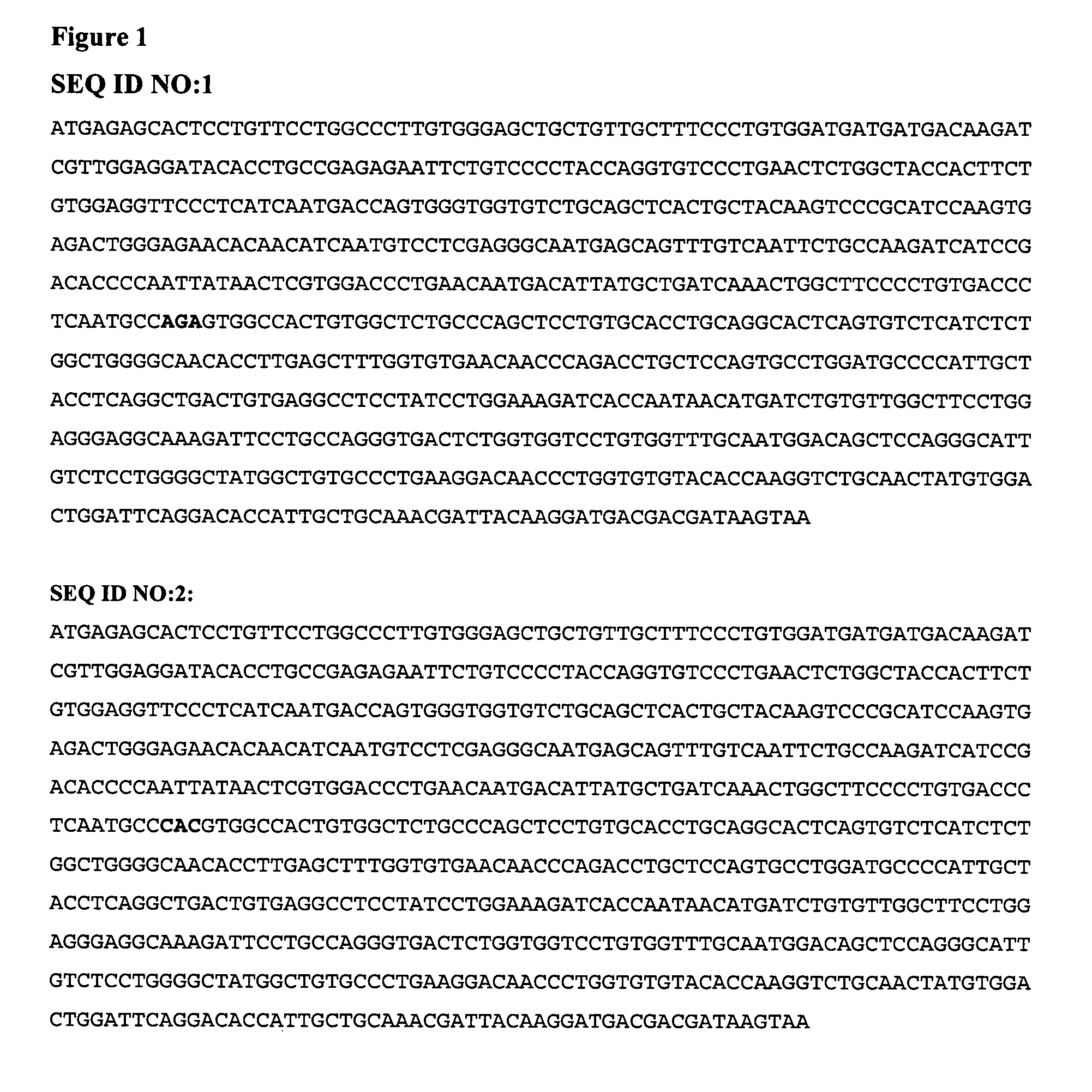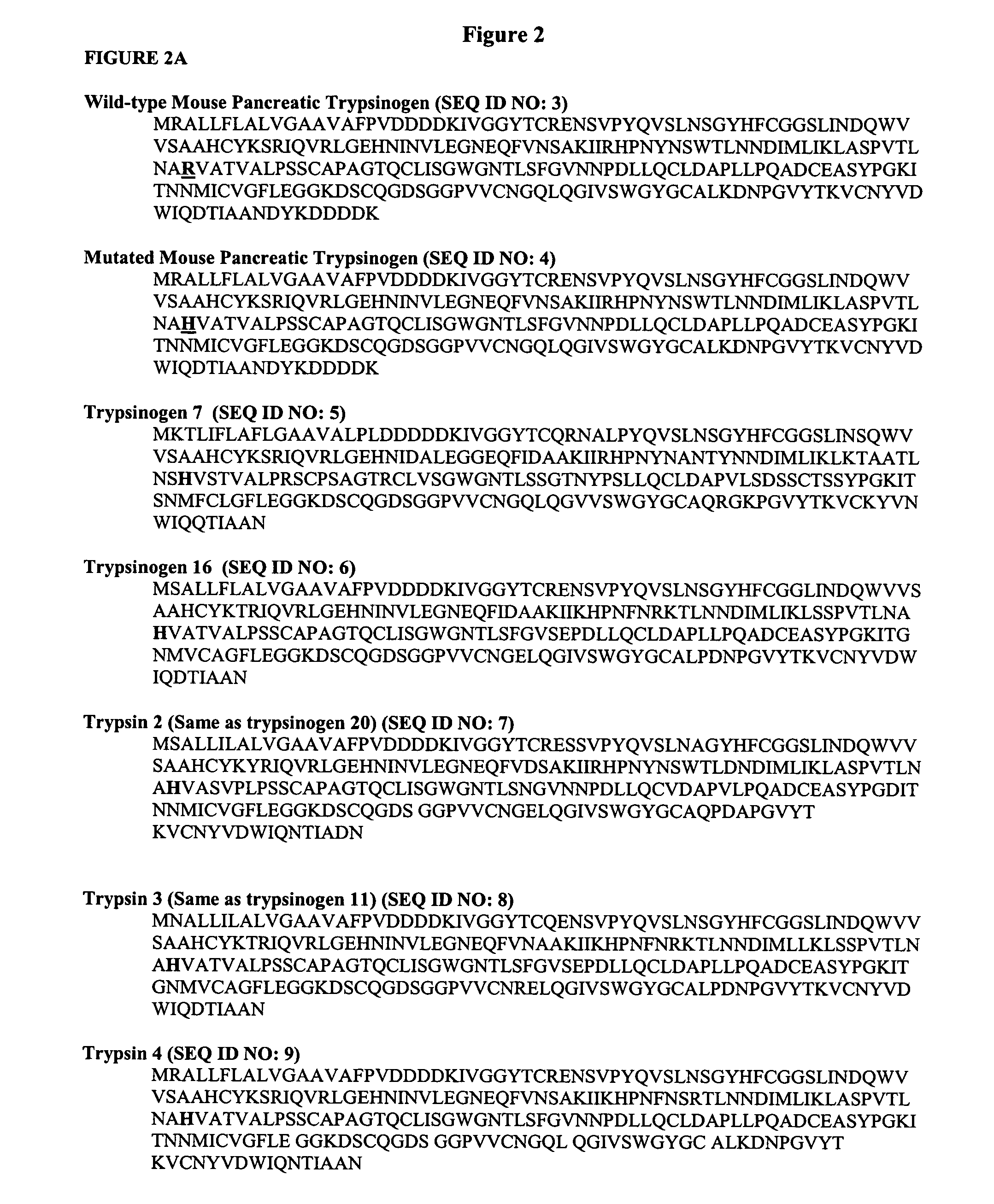Transgenic animal model for chronic pancreatitis
a technology of chronic pancreatitis and transgenic animal models, which is applied in the field of transgenic animal models of chronic pancreatitis, can solve the problems of lack of pancreatic enzymes, insulin is also affected, and the ability to properly digest fat is also affected
- Summary
- Abstract
- Description
- Claims
- Application Information
AI Technical Summary
Benefits of technology
Problems solved by technology
Method used
Image
Examples
example 1
Isolation of Mouse Pancreatic Trypsinogen
[0091] To ensure the use of an expressed isoform of mouse pancreatic trypsinogen in the generation of transgenic mice, wild-type mouse pancreatic trypsinogen was first isolated from mouse pancreas by RT-PCR. Mouse pancreatic trypsinogen was chosen for use in this model system in order to minimize the possibility of generating an immune rejection within the transgenic mouse, as well as minimizing the possibility that species differences in leader sequences might alter the localization of the chosen trypsinogen. Fresh mouse pancreas was flash frozen and ground by mortar and pestle in the presence of RLT lysis buffer (Qiagen) containing β-mercaptoethanol. Total mouse pancreas RNA was obtained by use of the RNeasy kit (Qiagen), and was shown to be intact. This RNA population was reverse transcribed using oligodT as a primer for SuperScript II Reverse Transcriptase (Invitrogen). The first strand cDNA library thus generated was used as the templat...
example 2
Generation of Transgenic Mice
[0095] Transgenic mice bearing the mouse trypsinogen mR122H isoform were generated by the University Transgenic Mouse Facility (SUNY Stony Brook, N.Y.). Briefly, the mouse mR122H trypsinogen construct described above was linearized using the unique restriction sites Sac1 and PshA1. The 3.2 kB fragment obtained from this digestion (containing the elastase promoter, mR122H cDNA, B-globin intron, Ires-GFP, and the SV40 polyadenylation signal), was injected into the fertilized pronuclei of C57 / B16 mice (FIG. 3). Mice were maintained in accordance with Institutional Animal Care and Use Committee protocols, and were bred after the age of 6 weeks. A total of 27 animals were screened for transgene incorporation using a nested PCR screen directed against the GFP portion of the transgene. Specifically, the primers used for this screen were:
(SEQ ID NO: 20)Round 15′ ATGGTGAGCAAGGGCGAGGAGCTG,(SEQ ID NO: 21)Round 25′ CAGCTCGTCCATGCCGAGAGTGAT,and(SEQ ID NO: 22)Round...
example 3
Histological Evaluation
[0098] Transgenic animals were sacrificed and analyzed for pancreatic morphology at varying time points after weaning. Upon sacrifice, the head of the pancreas was fixed and used for paraffin embedded sections, the body was snap frozen for frozen sections, and the tail was snap frozen for use in protein and mRNA analysis. For immunohistochemical staining, paraffin embedded pancreata were sectioned to 5 μm thickness, deparrafinized with two changes of xylene, and rehydrated through a graded alcohol series. Endogenous peroxidase activity was quenched with a 3% H2O2 solution, and antigenicity was recovered by boiling the sections in a 0.01M citrate buffer (pH 6.0). The sections were blocked with serum from the species in which the secondary antibody was raised, and primary antibodies were then added in the following dilutions: anti-Ki67 1:500 (Novocastra), anti-CD45 1:50 (BD Biosciences), anti MMP-7 1:1000 (gift from Dr. Howard Crawford), anti-Insulin 1:100 (Lin...
PUM
| Property | Measurement | Unit |
|---|---|---|
| Fraction | aaaaa | aaaaa |
| Nucleic acid sequence | aaaaa | aaaaa |
Abstract
Description
Claims
Application Information
 Login to View More
Login to View More - R&D
- Intellectual Property
- Life Sciences
- Materials
- Tech Scout
- Unparalleled Data Quality
- Higher Quality Content
- 60% Fewer Hallucinations
Browse by: Latest US Patents, China's latest patents, Technical Efficacy Thesaurus, Application Domain, Technology Topic, Popular Technical Reports.
© 2025 PatSnap. All rights reserved.Legal|Privacy policy|Modern Slavery Act Transparency Statement|Sitemap|About US| Contact US: help@patsnap.com



